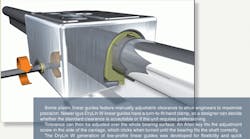Steel ball bearings are quite common, but plastic linear bearings and guides are increasingly tough — so their use is on the rise. Instead of riding on rolling balls, plastic linear bearings ride on sliding elements.
Because they have no moving parts, they can accelerate faster. In fact, only heavy loads and drive and motor limitations restrict the theoretical speed of a guide system using plastic sliding elements.
Plastic versus ball bearings
Standard ball bearings have point-to-point contact with their supporting rails; in contrast, plastic linear bearings have a much greater surface contact with their rails.
During high acceleration or deceleration, ball bearings can also be prone to skidding: Their inertia must be overcome, so the balls first slide and push against one another (or their cage) before speed or motion become constant, and the balls begin to roll. Because this sliding can cause scoring on the shaft, it sometimes forces engineers to lower cycle times.
Engineered-plastic bearings have no such issues. They also require no lubrication, making them advantageous in packaging and medical applications requiring clean designs.
Special considerations
Engineered polymers (designed for no measurable wear over millions of cycles, and a low coefficient of friction) are typically used for the bearing's replaceable plastic liner. Aluminum shafting has better thermal conductivity when compared to ferrous materials, so it is typically paired with the bearings.
Because both elements weigh less than their steel counterparts, this arrangement is also useful where low machine weight is a design objective.
High speeds (to 65 feet per second) are no problem, unless loads are particularly heavy, as high loads cause frictional heat buildup and are generally not recommended for any sliding bearings, including plastics. In high-acceleration applications, plastic linear bearings can require additional drive force — particularly if the payload's center of gravity is uncentered. If an application has accelerations greater than 1g, a manufacturer consultation is recommended.
These tips are provided by igus Inc., East Providence, R.I. For more information on plastic linear bearings and guides, visit igus.com or call (888) 803-1895. To watch videos of plastic linear guides in action, visit igus.com/ApplicationCorner/DL_videos.asp.
Some plastic linear guides feature manually adjustable clearance to allow engineers to maximize precision. Newer igus DryLin W linear guides have a turn-to-fit hand clamp, so a designer can decide whether the standard clearance is acceptable or if the unit requires pretensioning.
Tolerance can then be adjusted over the whole bearing surface. An Allen key fits the adjustment screw in the side of the carriage, which clicks when turned until the bearing fits the shaft correctly.
The DryLin W generation of low-profile linear guides was developed for flexibility and quick assembly by offering hard-anodized aluminum single and double-rail configurations; the self-lubricating triboplastic helps carriages glide smoothly over the rails.
igus DryLin W carriages also form the basis for some ready-to-install linear slide tables, to which the new clearance adjustment can also be added.
